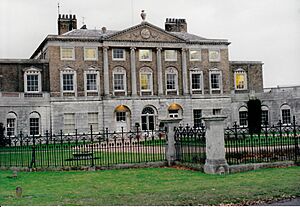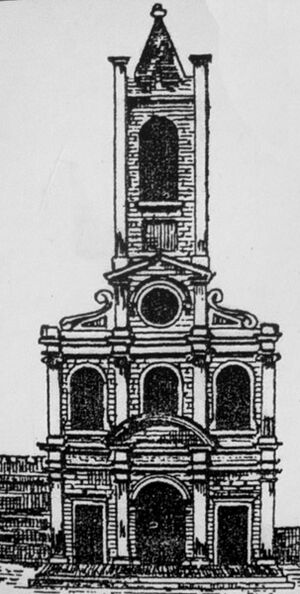Nathaniel Catelyn facts for kids
Sir Nathaniel Catelyn (born around 1580 – died 1637) was an important English politician and judge in Ireland during the 1600s. He was the Speaker of the Irish Parliament from 1634 to 1635. He also held important legal jobs like Recorder of Dublin and was the first Second Serjeant-at-law. Even though some people accused him of having conflicts of interest or being too friendly with Roman Catholics, he kept the King's trust. He was a key helper for Thomas Wentworth, who was the powerful Lord Deputy of Ireland.
Contents
Early Life and Career Beginnings
Nathaniel Catlyn was born in Suffolk, England, around 1580. He was the younger son of Richard Catlin III, who lived at Woolverstone Hall near Ipswich. His family owned land and were often involved in law and politics. Many of his relatives, like his grandfather and cousins, were also important figures in law or served as Members of Parliament for Norwich.
He went to Emmanuel College, Cambridge in 1601 and then studied law at Lincoln's Inn in 1605. For a short time, it seemed he might become a church minister, as he was ordained a deacon in 1620. However, he decided to become a lawyer in Ireland instead. He joined King's Inns, a legal society in Ireland, in 1622 or 1623. In 1626, he became the Recorder of Dublin, which meant he was a legal advisor to the city.
Becoming a Top Lawyer
In 1627, Nathaniel Catlyn was given a new and important job: Second Serjeant-at-law in Ireland. This was a high-ranking legal position, helping the King with legal matters. The King created this new role because he felt there was a lot of legal work to do.
When there was a question about how important this new job was, King Charles I himself decided. He ruled that the Second Serjeant should be very important, even more so than the Attorney General or Solicitor General in Ireland. Catlyn was also allowed to keep his job as Recorder of Dublin, meaning he could work for both the King and the city. This dual role later caused him some trouble.
The Dublin Riots of 1629
In 1629, the King decided to strictly enforce laws against Roman Catholics in Dublin, even though he had allowed them to practice their faith openly for some years. On December 26, news spread that soldiers were coming to stop Catholic religious services. This led to a serious riot. A large crowd threw stones at the Anglican Archbishop of Dublin, Lancelot Bulkeley, who had to hide for safety.
To calm the rioters, the city leaders stopped the soldiers from entering Dublin. When the Archbishop complained about being in danger, Catlyn, as the Recorder, defended the city's right to keep the peace. King Charles I was very upset that one of his own legal officers questioned his authority. He ordered Catlyn to be fired from his job as Recorder, calling him a "ringleader" of the trouble.
However, the Lord Deputy of Ireland, Lord Falkland, who liked Catlyn, arranged for him to speak in his own defense. Catlyn argued strongly that he was just doing his job as a lawyer for the city, which had elected him. He explained that the Recorder of Dublin, like the Recorder of London, served "two masters"—the Crown and the City. The Privy Council of Ireland accepted his arguments, and he was put back in his job. This event did not hurt his career in the long run. In fact, he was praised for his good service in 1632 and later received a knighthood. This incident also made many people believe he was sympathetic to Catholics, which made him popular among them.
Working with Lord Strafford
Under the strong leadership of Thomas Wentworth, 1st Earl of Strafford, Nathaniel Catlyn played a very important part in the government for three years. He regularly sat in the Court of Castle Chamber, which was like a special court in Ireland. He was involved in important cases, such as one about the management of Youghal College. This case was a big test of Strafford's power against his rival, Richard Boyle, 1st Earl of Cork. In 1635, Catlyn was the main lawyer for the Crown in a case to prove the King's ownership of lands in County Roscommon. Strafford praised him for his excellent work.
Speaker of the Irish Parliament
One of Lord Strafford's main goals was to show that the King could control the Irish Parliament. To do this, he needed a Speaker who would follow the King's instructions. Strafford chose Catlyn, calling him "a very able man" who would always serve the King. Some people believe Strafford also chose Catlyn to make the Roman Catholic members of Parliament happy, as Catlyn was seen as friendly towards Catholics, even though he was a Protestant.
However, Catlyn failed to get elected to the Irish House of Commons at first. Strafford dealt with this problem in a very strict way. He called the Sheriff of Dublin City, who had allowed the "wrong" candidate to be elected, before the Court of Castle Chamber. The Sheriff was fined a lot of money and banned from his job for life. After this, the voters elected Catlyn as the member for Dublin City. Strafford then clearly told the Commons that he would not accept any Speaker who was not approved by the King, making it clear that Catlyn was his only choice. The Commons then elected Catlyn, who managed the Parliament exactly as Strafford wanted. This disappointed the Catholic members, who had hoped for more changes.
Later Life and Family
It was common for top lawyers like Catlyn to also act as judges in different parts of the country. Nathaniel Catlyn was working as a judge in Cavan when he died on April 5, 1637. He was buried in the Church of St. Nicholas Within, Dublin.
He was married twice. His first wife was Maria Turner, and his second was Rebecca Thimbleby. Rebecca was the third daughter of William Thimbleby of Dublin. It seems he did not have any children from either marriage. After Catlyn's death, Rebecca married again to Sir Erasmus Borrowes, who was a High Sheriff of Kildare. Rebecca died in 1682.



